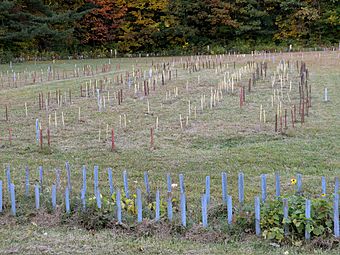Caughnawaga Indian Village Site facts for kids
Quick facts for kids |
|
|
Caughnawaga Indian Village Site
|
|

Site of Caughnawaga with stakes marking the lines of the stockade and long houses.
|
|
| Nearest city | Fonda, New York |
|---|---|
| Area | 135 acres (55 ha) |
| Built | 1666 (or 1679) |
| NRHP reference No. | 73001207 |
| Added to NRHP | August 28, 1973 |
The Caughnawaga Indian Village Site (also called the Veeder site) is an amazing place in Fonda, New York. It's where a real Mohawk nation village stood over 300 years ago! The Mohawk people were part of the Five Nations (also known as the Haudenosaunee). They lived in the Mohawk Valley, west of Albany. Other Iroquois nations lived nearby, south of the Great Lakes.
The Mohawk people traded with French settlers from Quebec. They also traded with the Dutch and later the English who lived in Albany. In the late 1600s, some Mohawk moved to new areas. Some who became Catholic moved to special mission villages. These were near Montreal and along the St. Lawrence River.
During the American Revolutionary War, most Mohawk in New York sided with Great Britain. After the war, they had to leave New York. The British Crown gave them new land in Canada. This land became the Six Nations of the Grand River in Ontario.
A man named Rev. Thomas Grassmann found this old village site in 1950. It's the only Mohawk village site in the United States that has been fully dug up and studied by archeologists.
Exploring the Caughnawaga Site
This special Mohawk village site is now open to everyone! You can walk around and see where everything used to be. Markers show the outlines of 12 longhouses. These were the large homes where families lived. You can also see the lines of the stockade, which was a tall fence for protection.
The site is on a hill, giving it a good view. In 1973, this archeological site was added to the National Register of Historic Places. This means it's a very important historical spot.
The Caughnawaga site is part of the Saint Kateri Tekakwitha National Shrine & Historic Site. This place honors Kateri Tekakwitha. She was the first Native North American saint in the Roman Catholic Church. She became a saint in 2012. You can also visit the Mohawk-Caughnawaga Museum nearby. It has many cool items found during the digs at the village site.
The name Caughnawaga comes from the Mohawk language. It means "place of the rapids." This refers to the fast-moving water in the nearby Mohawk River. The site is also known as Indian Castle. In Mohawk, this is Gandaouage or Kachnawage, meaning "castle" or "fortified place." The village had a strong fence, like a castle. It is on the north side of the Mohawk River and close to a natural spring.
History of the Village
The Mohawk people lived at Caughnawaga from at least 1666 to 1693. French Jesuits (Catholic priests) started a mission here. It was active for about 10 years, from 1668 to 1679. The Jesuits taught some Mohawk people to read and write in French. They also taught them about Christianity.
Historians now think that the village called "Caughnawaga" was first located upstream at the "Fox Farm site." Then, around 1679, the village moved to this exact spot.
An archeologist named Dean Snow believes about 300 people lived in this village. This was fewer than at the earlier Fox Farm site. By 1679, some Catholic Mohawk people had moved away. They went to a mission village called Kahnawake. This village was south of Montreal along the St. Lawrence River. Today, Kahnawake is one of several Mohawk reserves in Canada.
The Caughnawaga site in New York is now a place for fun and learning. It helps people understand Mohawk culture and history.
Gallery
See also
 In Spanish: Caughnawaga para niños
In Spanish: Caughnawaga para niños




